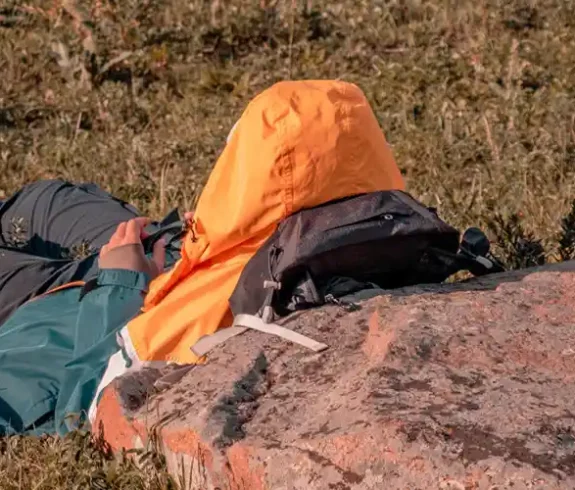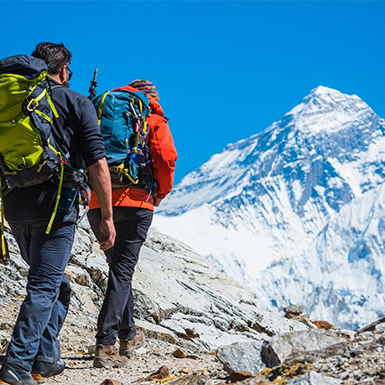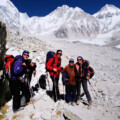Ever feel unwell when climbing high? That might be Acute Mountain Sickness, or AMS for short. It’s a common condition triggered by the body’s struggle to adapt to thinner air at higher altitudes. While most cases occur above 8,000 feet, some might feel it sooner. Understanding and preventing AMS is your ticket to safe mountain escapades.
AMS vs. Its Nastier Cousins
AMS represents the mildest form of altitude sickness. But ignoring it can lead to scarier situations:
- High Altitude Cerebral Edema (HACE): Your brain swells dangerously.
- High Altitude Pulmonary Edema (HAPE): Fluid floods your lungs.
All three stem from low oxygen, but AMS is more like a warning sign, while HACE and HAPE demand urgent medical help.
Spotting the Red Flags: AMS Symptoms
Catching AMS early is key. Watch out for these telltale signs:
- Pounding headache: This is the most common symptom.
- Queasy stomach: You might feel nauseous or even throw up.
- Wobbly legs: Dizziness and lightheadedness can strike.
- Feeling wiped out: Fatigue and weakness can set in.
- Sleepless nights: You might have trouble falling or staying asleep.
- No appetite: Food might lose its appeal.

Causes of Acute Mountain Sickness (AMS): Decoding the Altitude Effect
High altitudes offer stunning vistas but bring a challenge: thin air. As you ascend mountains, the air pressure drops, reducing the oxygen available in each breath. This oxygen deprivation, known as hypoxia, strains your body. Accustomed to the oxygen-rich environment of lower elevations, your body struggles to cope. This struggle triggers a chain reaction within your system, leading to the unpleasant symptoms of Acute Mountain Sickness (AMS).
Who’s Vulnerable? Deciphering Your AMS Risk
Anyone can experience AMS, but certain factors amplify your susceptibility:
- Fast Climbs, Big Risks: Picture your body as a car trying to race uphill – it needs time to adjust. Similarly, ascending too quickly overwhelms your body’s ability to acclimate to the thinning air. Ascending gradually with planned rest days empowers your body to generate more oxygen-carrying red blood cells and fine-tune its breathing patterns, effectively minimizing the risk of Acute Mountain Sickness (AMS).
- Altitude Matters: The higher you go, the scarcer the oxygen becomes, and your risk of AMS increases. While AMS typically sets above 8,000 feet (2,400 meters), some individuals may experience symptoms at lower altitudes.
- Your Body’s Unique Response: We all react differently to altitude. Your genes, age, health, and past experiences at high altitudes influence your susceptibility to AMS. If you’ve had AMS before, you’re more likely to experience it again.
Hidden Culprits: Other Factors at Play
Beyond the obvious, several other factors can contribute to your AMS risk:
- Dehydration’s Double Whammy: High altitudes can quickly dehydrate you, worsening AMS symptoms. Staying hydrated is vital for acclimatization and well-being at high altitudes.
- Pushing Too Hard: Overexerting yourself during acclimatization can hinder your body’s adaptation process. Listen to your body’s cues and incorporate rest days to adjust.
- Hidden Saboteurs: Alcohol and certain medications can interfere with your body’s ability to acclimatize, making you more vulnerable to AMS.
Symptoms of Acute Mountain Sickness (AMS): Decoding Your Body’s High-Altitude Signals
AMS often starts subtly. Pay attention to these early cues:
- Throbbing Headache: AMS’s signature symptom is a pulsing pain that often worsens with movement.
- Upset Stomach: Nausea and vomiting can quickly follow, making it hard to keep food down.
- Dizzy Spells: You might feel unsteady or as if the world is spinning.
- Exhaustion Sets In. Even simple tasks become tiring, and you might feel short of breath.
These initial AMS signs usually appear within 6-12 hours of reaching higher altitudes. Catch them early to prevent the condition from worsening.
Red Alert: Recognizing Escalating AMS
Ignoring AMS can have serious consequences. Watch out for these alarming signs:
- Relentless Headache: The pain intensifies, becoming constant and resistant to painkillers.
- Persistent Nausea and Vomiting: You can’t keep anything down, leading to dehydration.
- Crippling Fatigue: Even basic movements become a struggle, and coordination suffers.
- Gasping for Air: Shortness of breath at rest signals a severe oxygen shortage and demands urgent action.
- Foggy Brain: Confusion and difficulty thinking indicate that your brain lacks oxygen.
If you notice these escalating symptoms, act fast. Descending to a lower altitude is often necessary.
Beyond AMS: Identifying High-Altitude Crises
AMS is the mildest form of high-altitude sickness, but two life-threatening conditions can develop:
- High Altitude Cerebral Edema (HACE): Brain swelling leads to confusion, clumsiness, odd behavior, and potentially coma.
- High Altitude Pulmonary Edema (HAPE): Fluid buildup in the lungs causes severe breathlessness, coughing, and a crackling sound in the chest.
Prevention Strategies: Your Defense Against Acute Mountain Sickness
High-altitude adventures shouldn’t mean battling Acute Mountain Sickness (AMS). Understand the science behind AMS, take proactive steps, and minimize your risk for a safer, more enjoyable experience. Gradual ascents, smart acclimatization, and knowing your limits are essential. Additionally, medications and lifestyle tweaks can fortify your defenses against AMS. Remember, preparation is your best weapon in the thin mountain air.
Acclimatize for Altitude Success
Think of acclimatization as high-altitude training for your body. It gradually adapts to thinner air, boosting red blood cell production and refining breathing. It is the cornerstone of Preventing Acute Mountain Sickness and enjoying a smooth trip.
Pace Yourself: A Smart Ascent Strategy
Slow and steady beats AMS every time. Once you hit 8,000 feet (2,400 meters), adhere to these guidelines:
- Climb no more than 1,000 feet (300 meters) daily.
- Rest for a day or two after every 3,000-4,000 feet (900-1,200 meters) gained.
- Sleep lower than your peak daily altitude.
Medication: An Extra Shield
For some, preventative medication can be a lifesaver against AMS. Acetazolamide (Diamox), a prescription drug, can accelerate acclimatization and reduce the chances of AMS symptoms. Talk to your doctor to see if it’s right for you.
Lifestyle Tweaks for a Smoother Climb
Beyond Acclimatization tips and medication, confident lifestyle choices can lower your AMS risk:
- Hydrate: Drink lots of fluids, especially water, to counter the dehydrating effects of altitude.
- Hold the Booze: Alcohol worsens dehydration and disrupts sleep, both enemies in the fight against AMS.
- Fuel Your Body Right: Favor carbs for energy, and avoid heavy, greasy foods that can make you queasy.
- Catch Enough Z’s: Adequate sleep helps your body recover and adjust to the altitude.
- Listen to Your Body: If AMS symptoms arise, wait to ascend further until they subside.
Your Acute Mountain Sickness – First Aid Guide
Don’t brush off mild AMS symptoms. Take these steps right away:
- Pause Your Ascent: Stop climbing immediately. Pushing higher can make things worse.
- Rest and Rehydrate: Give your body a break and drink plenty of fluids. High altitudes are dehydrating, so replenishing fluids is vital.
- Ease the Pain: Over-the-counter pain meds like ibuprofen can help with headaches and discomfort.
- Track Your Progress: Keep a close eye on how you feel. If rest and hydration do the trick, you can continue your climb gradually after a day or two.
Medication: Your AMS Ally
Aside from rest and fluids, certain medications can help manage AMS:
- Acetazolamide (Diamox): This prescription drug speeds up acclimatization and eases AMS symptoms. It boosts your breathing, increasing oxygen in your blood.
- Dexamethasone: This steroid medication tackles more severe AMS symptoms, like persistent headaches or nausea.
When to Descend or Seek Help: Your Safety Net
If AMS symptoms don’t improve or worsen despite rest and meds, descend immediately. Additionally, seek medical help if you experience:
- Severe headache, unresponsive to painkillers
- Escalating nausea and vomiting
- Increasing weakness or dizziness
- Breathlessness, even when resting
- Confusion or trouble thinking
Portable Altitude Chambers: Your Emergency Oxygen Boost
Portable altitude chambers (PACs) can be lifesavers for severe AMS or other altitude-related illnesses. They mimic lower altitudes, providing more oxygen and aiding recovery. For high-altitude adventures, especially in remote areas with limited medical access, consider packing a portable altitude chamber (PAC) as an extra layer of safety.
Real-World Cases, Research, and Essential Advice
Acute Mountain Sickness (AMS) doesn’t just exist in medical textbooks. It’s a real risk faced by adventurers of all kinds, as these real-life cases illustrate:
- Trekking: A 2019 study on Mount Kilimanjaro revealed that many trekkers experienced AMS symptoms, with some cases escalating into more severe altitude-related illnesses. It emphasizes the importance of meticulous acclimatization and early symptom recognition for trekkers.
- Skiing: A case study documented a seasoned skier’s unexpected encounter with AMS during a backcountry skiing trip in the Colorado Rockies. The symptoms of headache, nausea, and dizziness impaired the skier’s navigation skills and put them in danger, highlighting the need for AMS awareness even for experienced winter sports enthusiasts.
- Military Missions: Soldiers operating at high altitudes are prone to AMS, which hinders their performance and jeopardizes missions. A study published in Military Medicine underscored the necessity of implementing AMS prevention strategies and establishing treatment protocols for military personnel operating at high altitudes.
Pioneering Research: Advancements in AMS Prevention and Treatment
Ongoing research continues to unveil effective strategies for combating AMS:
- Gradual Ascents for Smooth Acclimatization: A comprehensive review in The Lancet reaffirms that slow, steady ascents and proper acclimatization are the most effective defenses against AMS. This method lets your body gradually adapt to the thinner air by pacing your ascent and incorporating rest days into your itinerary.
- Acetazolamide (Diamox): A meta-analysis published in the Cochrane Database of Systematic Reviews confirmed that acetazolamide effectively prevents and treats AMS. The analysis concluded that this medication significantly reduces the frequency and severity of AMS symptoms.
- Portable Altitude Chambers (PACs): Research published in the Journal of Wilderness and Environmental Medicine showcases the lifesaving potential of PACs for severe AMS. These chambers simulate descending to lower altitudes, rapidly improving symptoms and preventing further complications.
Your High-Altitude Adventure Kit: A Shield Against Acute Mountain Sickness
Are you planning a high-altitude adventure? Don’t let Acute Mountain Sickness (AMS) crash your party. Pack smart, know the signs, and be prepared for a safe and exhilarating experience. Essentials for Your High-Altitude Pack:
- Medications: Bring over-the-counter pain relievers for headaches and acetazolamide (Diamox) if your doctor prescribes it for AMS prevention.
- Hydration: Pack a reusable water bottle and electrolyte tablets to combat dehydration at higher elevations.
- Clothing: Layer up for unpredictable mountain weather. Include warm layers, rain gear, and sun protection.
- First-Aid Kit: Ensure your kit includes supplies to manage AMS symptoms like nausea and minor injuries.
- Portable Altitude Chamber (PAC): If you’re heading into remote areas, consider packing a PAC for emergency Treatment for AMS.
Stay Alert: Monitor Yourself and Your Team
Remember these Acclimatization tips: Detecting AMS first is critical to staying safe.
- Self-Check: Tune into your body’s signals. Don’t ignore headaches, nausea, dizziness, fatigue, or shortness of breath.
- Buddy Up: Regularly check in with your adventure buddies. Ask how they’re feeling and watch for any signs of AMS.
Safety First: Insurance and Emergency Planning
Before you set off on your high-altitude adventure, take these precautions:
- Travel Insurance: Verify that your travel insurance covers medical evacuation for high-altitude illnesses like AMS.
- Emergency Contacts: Share your itinerary and expected return date with a trusted person.
- Local Resources: Research medical facilities and emergency services available at your destination.
- Communication is Key: A reliable way to communicate in emergencies, like a satellite phone or personal locator beacon.
Impact of AMS on Health and Activities
Don’t dismiss Acute Mountain Sickness (AMS) as a minor annoyance. Left untreated, it can cast a long, ominous shadow on your health. Those initial headaches and nausea can escalate into severe, life-threatening conditions like High Altitude Cerebral Edema (HACE), characterized by brain swelling, and High Altitude Pulmonary Edema (HAPE), where fluid fills your lungs. These conditions can cause lasting harm or even prove fatal if you neglect them.
In rare instances, repeated bouts of severe AMS can trigger chronic mountain sickness (CMS). CMS causes an overproduction of red blood cells, thickening your blood and potentially leading to complications like heart failure and stroke.
AMS Takes a Toll: Compromised Performance and Safety
Even a mild case of AMS can drastically affect your physical abilities and judgment, putting you at risk in high-altitude environments.
- Reduced Physical Performance: Fatigue, breathlessness, and muscle weakness hinder your ability to hike, climb, or ski effectively. It slows you down, increases your risk of falls, and can make it challenging to complete your planned activities.
- Clouded Judgment: The dizziness and mental fog associated with AMS can impair your decision-making. You might make risky choices, like pushing upward despite worsening symptoms or taking unnecessary chances on challenging terrain.
- Higher Accident Risk: Physical limitations and impaired judgment increase your risk of accidents and injuries. Simple missteps can have dire consequences at high altitudes.
Prioritize Your Well-being: AMS is No Trivial Matter
Although AMS is often temporary and treatable, it demands your attention. Recognizing and addressing the early symptoms can prevent its progression into more severe forms of high-altitude sickness.
Remember, your safety and health in the mountains hinge on your ability to make wise choices and take decisive action. If you experience any AMS symptoms, stop your ascent, rest, hydrate, and consider descending to a lower altitude if necessary. Don’t underestimate the risks of AMS – your mountain adventure is worth protecting.







